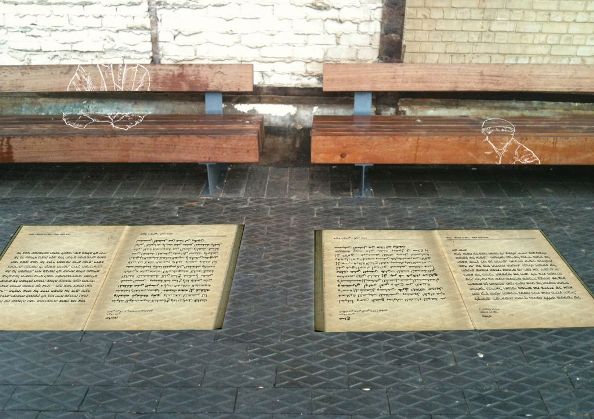
“Shibboleth”: A Site Specific Exhibition will open at Jaffa Port on April 15, 2011 at noon, with a performance by System Ali, the multi-lingual, multi-cultural Hip Hop Group. The port will be an integral part of this exhibit designed by students in the “Site Specific” course, directed by Anat Katsir of the Visual Communication Department at Bezalel Academy of Art and Design, Jerusalem who is curator of the exhibit, the outside spaces of the port have been transformed in relation to the term “Shibboleth.” The Hebrew word refers to flowers arising from the main stem – without individual flower stalks – and refers to distinguishing between ethnic groups based on linguistic differences.
A joint project of the Bezalel Visual Communications Department, 3M and Jaffa Port, the students’ projects will be displayed outdoors, in the open spaces of the port. The projects explore the meeting of two languages – Hebrew and Arabic – that exist in the Israeli environment. The students selected cultural references, such as poetry, literature, news excerpts, music, and even online comments, using them in the artworks scattered across the port.
The exhibition was organized with the help of: 3M Israel Ltd – an international company and leading innovator, Polakowski Ltd – Israel’s leading custom signs, road signs and signage systems manufacturer, and Elsop Fontisop Ltd – representing MIMAKI in Israel.
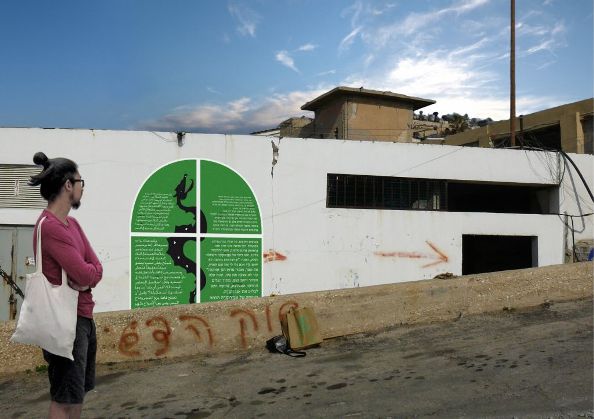
Projects which will be exhibited include:
Shlomit Sauer / Talkbacking Jaffa
Location: North pier
This past November, Nadav Man’s article titled: “There is Something Beautiful About This City: Images of Old Jaffa”, appeared on YNet. The responses to this article created a debate, which became a microcosm of the intricacy of the Jewish-Arab dynamic in the city and in general.
Omer Gaash / Hebrew Labor
Location: Northern wall of the restored hanger
An old ad from the 1930s, which called consumers to buy only Israeli-made products, was the basis for this critical piece, which presents it next to the calls made by rabbis to avoid renting out apartments to Arabs or hiring them.
Shiree Williamson / From National Concept to Acquisition Groups
Location: Glass doors of the southern entrance of the western fron of the restored hanger
“Our settlement is a means to saving and resurrecting our people; the goal is not the capitalist exploitation of land, and it is not driven by imperialistic intentions…”
A quote from Martin Buber’s speech at the 12th Zionist Congress in 1921 completely changes its meaning on the automatically opening and closing doors, which hide and reveal parts of the text.
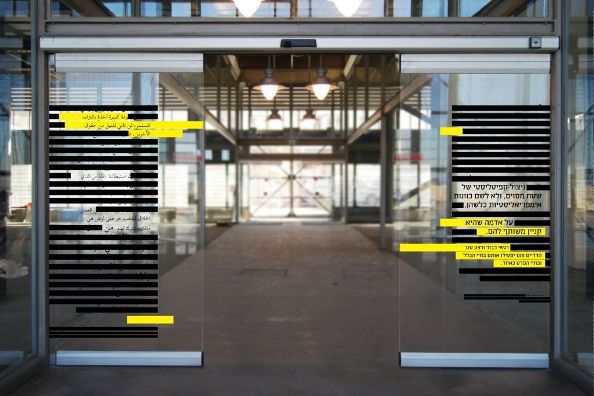
Yael Segal and Hila Zwergel / I write in Hebrew
Location: Concrete seating area, west of the circle
“I write in Hebrew / Which is not my native tongue / To lose myself in the world / … / And Hebrew / Sometimes I write / To stop the blood that drips / Relentlessly from the heart”
“I write Hebrew”, a poem by Palestinian poet, Salman Masalha, which reveals his complicated connection with the Hebrew language, was the basis for this project.
Elad Rahmin / No Co-existence!
Location: Map circle
Arabs, Jews and Christians, it doesn’t matter for us… We are all one family, you can’t say that there is or isn’t co-existence. There is no co-existence. This is existence.”
The words of Saadu Zeinab, head of the Jaffa Fisherman’s Committee, inspired this project
Galit Iofman / Andromeda, Then and Now
Location: Southern wall of the white structure at the right of the entrance, south of the “Please Touch” center
The myth of Andromeda, the princess tied to a rock off the cost of Jaffa as sacrifice for Poseidon’s monster, inspired this project, which is displayed at the foot of the Andromeda Complex and presents a critical look on it: Has the princess become a monster?
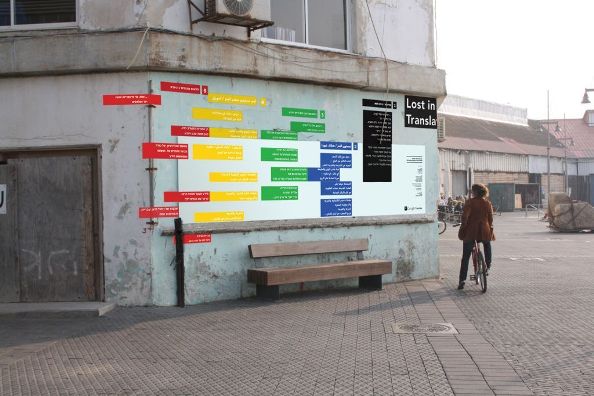
Liya Ophir / My Arabic is Silent
Location: Red wall and sidewalk south of the new gallery
“My Arabic is silent / Barely escapes the throat / Curses itself / Without a word / Sleeps in the thin air of my soul / Hides / From family / Behind the shutters of Hebrew.”
Almog Bahar’s poem, shifting from Hebrew to Arabic and vice versa, was the basis for the project.
Dvir Isac and Yotam Kellner / Lost in Translation
Location: Northeast side of the port administration building
The poem: “The Sea”, by Giora Leshem, inspired the project. The song was translated using Google Translate from Hebrew to Arabic, back to Hebrew, again to Arabic, and again to Hebrew. It shows the changes in meaning and what was lost in translation.
Achva Kahana / The Statistics of Separation
Location: The empty container, south of Container Restaurant.
A 3D graph depicting the opinions of the Jewish and Arabic population on integration is shown inside an old shipping container left at the port. The graph creates a fracture that appears as though it can never be fixed.
Ahuva Lebor / Five Recipes from five Fishermen
Location: Doors of five of the fishermen’s warehouses.
One of the strongest experiences that the students had during work on the project was meeting the Jaffa Port fishermen, the real people: Jews, Arabs, and Christians. In this project, the doors of the fishermen’s warehouses were used to present them and recipes gathered from them.
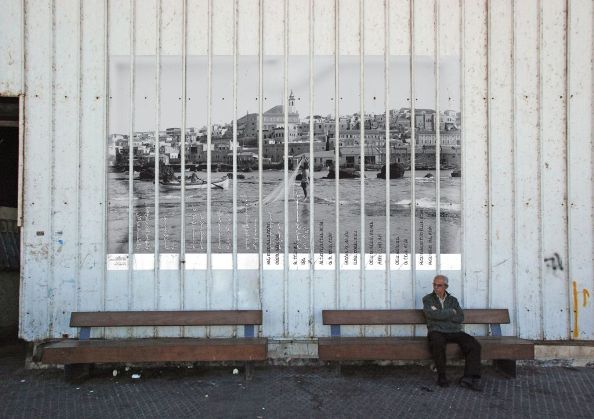
Reut Pintz /Where is My Home
Location: Metal wall above the benches, near the fishermen’s warehouses.
“Where is my home now? / Where are the walls that I was raised in? / Who is in my home now? / The home my grandfather built / Every stone he set / The home in which I played with my brothers / I ran in its corridors / I climbed its walls / Who lives in my home now / Arabs live in my home now / And I live in an Arab home / And I / Live in an Arab home / The immigrant who was raised here / May now be writing poems.
The poem by Moshe Ben Harash inspired the project, and it is displayed near the bench from which the fisherman, Jews, Arabs and Christian, see their home at the port.
Sharon Vazana and Adi Tako / Perspectives
Location: Two benches on the west side on the fishermen’s warehouses hanger
Two excerpts from Alon Hilu’s book, “The House of Rajani”, inspired the project. They show two points of view, two different descriptions of the same event, one from Chaim, who is Jewish, and one from Saleh, an Arab boy. They raise a comparison between truth and memory, objective reality and subjective experience.
Maya Sinai / See under Language
Location: Eastern wall of the southern hanger
Under a dictionary definition of “Language”, various texts were incorporated, which shine a critical and controversial light on the word.
Dan Greenberg / “Viena”, System Ali
Location: Southeast corner of the southern hanger
The song “Viena” by System Ali, the Jaffa Hip Hop group, inspires this project, a trilingual walking path around the structure.
The opening event will take place on April 15, 2011 at 12:00, with a performance by System Ali outside the old warehouse at Jaffa Port, and will remain up until April 30, 2011.






[…] – Shibboleth exhibit at Jaffa Port thru May 1st; Rappaport Prize winners Sharon Poliakine and Oren Eliav at the Tel Aviv […]
[…] Shibboleth – a site specific exhibition with designs by 14 students from the Visual Communications Department at Bezalel Academy of Art and Design, Jerusalem, curated by Anat Katsir. The outdoor spaces of the port will be transformed in relation to the term “Shibboleth” – creating a meeting place between the two languages existing in this space: Arabic and Hebrew. The exhibit will open on April 15, 2011 at noon, with a performance by System Ali, the multi-lingual, multi-cultural Hip Hop Group. You really want to be there! […]
[…] 15 – Shibboleth exhibit opens at Jaffa Port at 12:00, with a live performance by System Ali; Participation, a new […]
Comments are closed.